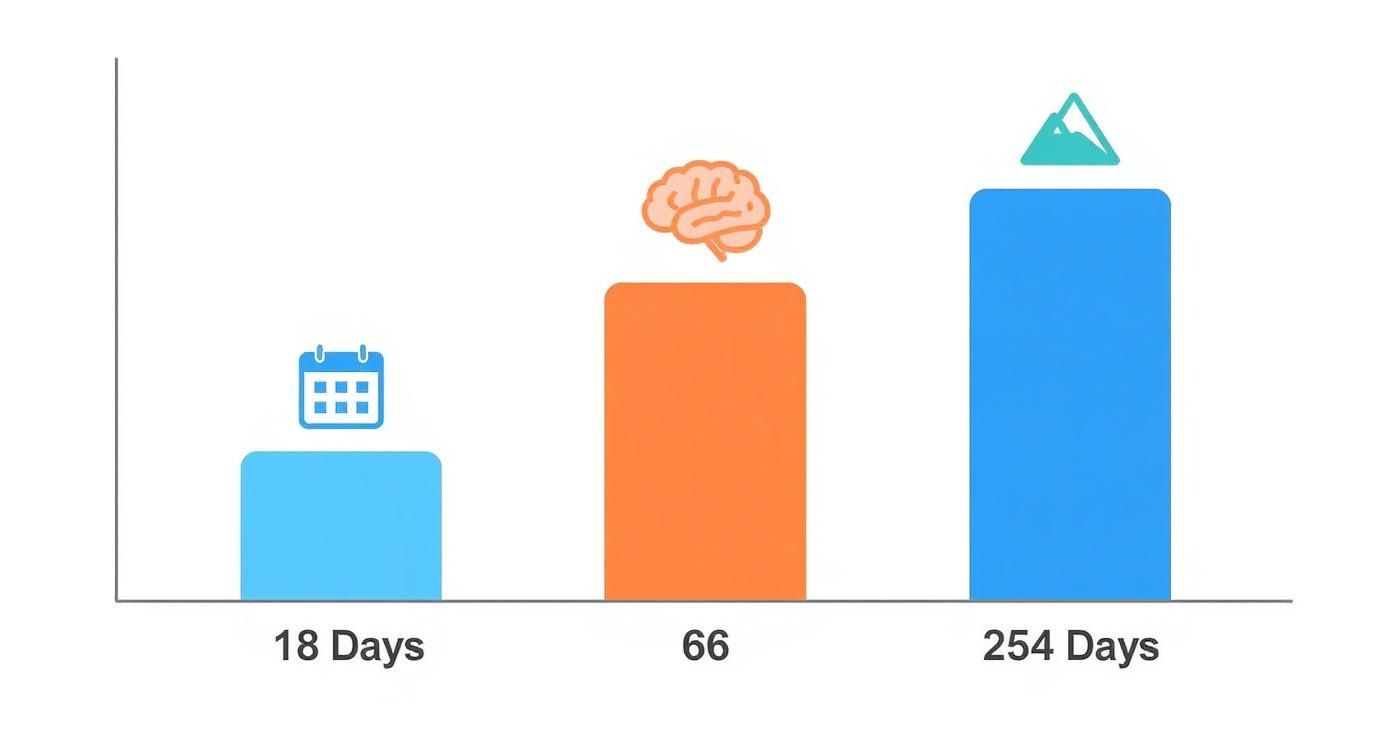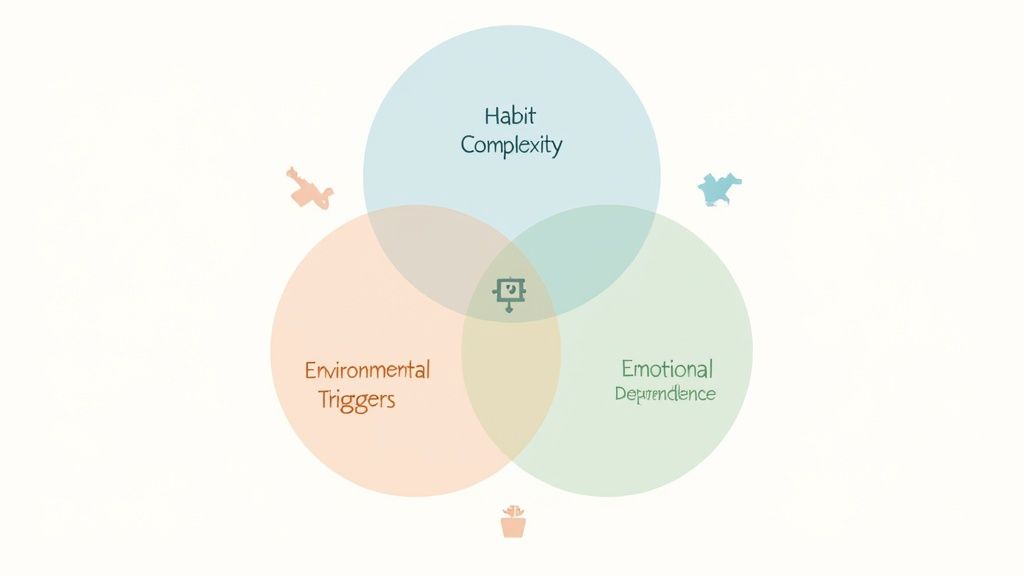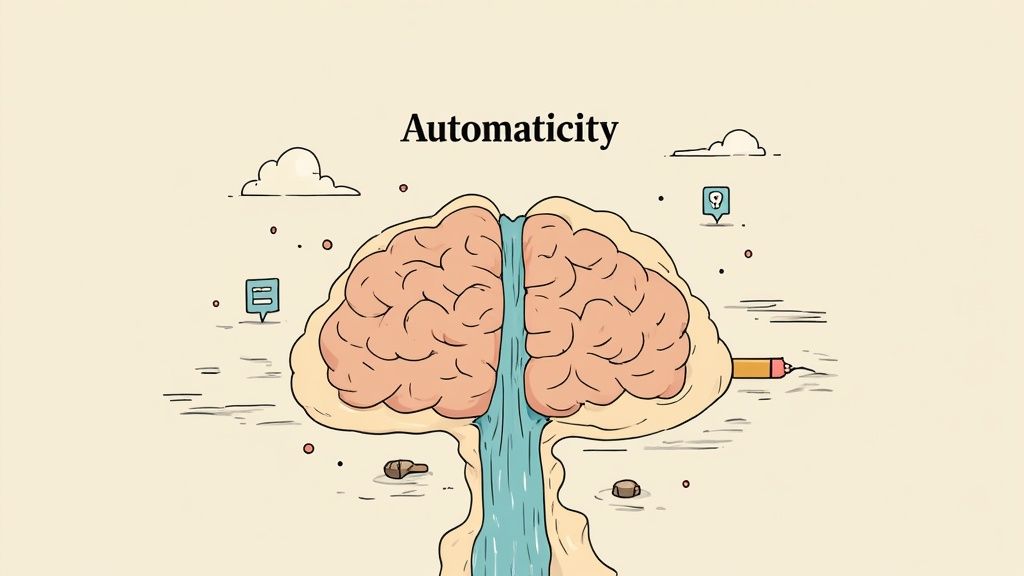how long does it take to break a habit? Timeline

So, how long does it really take to break a habit? If you've ever heard the "21-day rule," I've got some news for you: it's largely a myth. The truth is, research points to an average time of closer to 66 days.
But even that number doesn't tell the whole story. The real timeline is incredibly personal and can stretch anywhere from a brisk 18 days to a marathon 254 days. It all comes down to the person, the habit, and the circumstances.
The Real Timeline for Breaking a Habit
If you've ever felt like you failed because a bad habit didn't vanish in three weeks, let yourself off the hook. Changing your behavior is a lot more nuanced and personal than any single number can capture.
I like to think of it like forging a new trail in a dense forest. The old, well-worn path is your bad habit—it's automatic, easy, and you can walk it without even thinking. Carving out a new path means clearing away branches, packing down the dirt, and walking it over and over again until it becomes the new default.
This process takes time, and just how much time depends on the habit itself. For example, building a simple habit like drinking a glass of water every morning might take just a few weeks to stick.
But something more deeply wired, like changing how you instinctively react to stress? That's a much bigger undertaking. We see this with complex behaviors all the time. Our guide on the sugar detox timeline shows just how much structure and patience these kinds of changes demand.
Visualizing Your Habit-Breaking Journey
To set yourself up for success, it helps to manage your expectations and understand the huge range of possibilities. The chart below gives a great visual of the minimum, average, and maximum time it can take for a new behavior to feel automatic.

As you can see, some habits might click in just over two weeks, while others can take the better part of a year to become second nature. It's a huge spectrum.
To get a clearer picture of these timelines, here’s a quick summary of the key findings from habit formation research.
Habit Change Timelines at a Glance
| Timeframe | Description | Key Finding |
|---|---|---|
| 18 Days | The fastest observed time for a simple habit to become automatic. | Represents the absolute best-case scenario for an easy, consistent behavior. |
| 66 Days | The average time it took for a new habit to feel automatic in a key study. | A much more realistic benchmark than the popular "21-day rule." |
| 254 Days | The longest observed time for a habit to stick, for more complex behaviors. | Proves that difficult, deeply ingrained habits can take over 8 months to change. |
This data comes from a landmark study that really dug into this question. It confirmed that while the average sits around 66 days, the enormous range from 18 to 254 days is the most important takeaway. There's simply no magic one-size-fits-all number.
The key takeaway is this: Consistency, not speed, is the true engine of change. Your personal journey will have its own unique pace, and that's perfectly normal.
Why the 21-Day Habit Myth Is a Trap
Have you ever tried to break a habit, stuck with it for three weeks, and then felt like a total failure when it didn't stick? You’re definitely not alone. The idea that it takes just 21 days to change a behavior is everywhere. It’s a nice, tidy number that makes a tough process sound quick and easy.
The only problem is, it's not really true. And believing it can do more harm than good.
The whole thing started back in the 1960s with Dr. Maxwell Maltz, a plastic surgeon. He noticed that it took at least 21 days for his patients to adjust to a new look or for someone who had lost a limb to stop feeling a "phantom limb."
Somehow, his observation about a minimum time got twisted into a hard-and-fast rule for everyone. A thoughtful insight became a rigid deadline, setting countless people up for disappointment. When day 22 rolls around and you’re still fighting the same old urges, it’s easy to throw in the towel.
The Real Damage of a Fake Deadline
Buying into the 21-day myth sets a dangerous mental trap. It makes you think that rewiring your brain is a simple sprint to the finish line. So when you don't cross it in time, you’re more likely to blame a lack of willpower than the faulty timeline itself.
This mindset is especially crushing when you're trying to tackle habits that are deeply rooted in your life. Getting a realistic grip on how long it really takes to break a habit is the first step to freeing yourself from that pressure.
Real change isn’t a sprint; it’s more like a marathon. Letting go of the 21-day expectation is the first real step toward building the patience you actually need to succeed.
Instead of aiming for a quick fix, think about your own unique timeline. Ditching a simple habit like leaving your dirty socks on the floor is a whole different ballgame than overcoming something complex like emotional eating.
The journey is all about progress, not perfection. Once you accept that setbacks are part of the process and that it will take as long as it takes, you can be a lot kinder to yourself. That mental shift is what will keep you going long enough to see real, lasting change—whether it takes 30 days or 200.
Navigating the Three Stages of Habit Change
Figuring out how long it takes to break a habit makes a lot more sense when you realize it's a journey, not just a switch you flip. That journey has three distinct psychological stages, and each one comes with its own hurdles and wins. If you know which stage you're in, you have a roadmap for what’s coming next.

A great way to think about it is learning to drive a stick shift. Your old habit is driving an automatic car—you don't even have to think about it. The new behavior is getting the hang of that clutch and gearstick.
Stage 1: The Initiation Phase
This is the starting line. It’s that moment you make a conscious, deliberate decision to change. In our driving analogy, this is when you trade the automatic for the manual and get behind the wheel. You’re hyper-aware, you're motivated, and you’re mentally steeling yourself for the challenge.
The initiation stage is really all about setting your intention. You're making an active choice to stop grabbing a cookie at 3 p.m. or to finally stick to a morning workout. This phase runs on motivation, but it's also incredibly fragile because you haven't really done the hard work yet.
Stage 2: The Learning Phase
Alright, here comes the messy part. This is where things get clunky, awkward, and genuinely difficult. The learning phase is when you’re actively doing the new thing, and it drains your mental energy. It’s you, in the driver's seat, stalling the car, lurching forward, and constantly overthinking every move with the clutch and gas.
Every action feels forced. The temptation to just go back to the "automatic" way of doing things will be at its absolute peak. This is where most people give up, but it's also precisely where the magic happens. You're forging new neural pathways, one clumsy repetition at a time. The goal here is persistence, not perfection. For more on this, our guide on building healthy habits has some solid tips for pushing through.
Stage 3: The Stability Phase
Then, after enough practice, something amazing happens. You're shifting gears without even realizing it, cruising through traffic like a pro. The intense, conscious effort just melts away, and the new behavior becomes your new automatic. This is the stability phase—the point where the habit becomes part of who you are.
The new behavior becomes "second nature," which is the ultimate goal of habit formation. This shift from conscious effort to automatic action marks true, lasting change.
At this point, you don't need to white-knuckle your way through the day anymore. The change sticks. Research backs this up, showing that new habits hit this stability point and feel natural anywhere from two to eight months in. This is the moment the new path you've carved out finally feels as comfortable as the old one you abandoned.
Factors That Define Your Personal Timeline

Ever wondered why your friend can ditch their late-night snacking habit in a few weeks, while you've been battling the urge to scroll social media for months? The answer is simple: there's no generic timeline for breaking a habit. Your journey is shaped by a unique mix of factors that belong to you and you alone.
Getting a handle on these factors is the first step toward setting realistic expectations. It helps you move past arbitrary goals and build a smarter, more personalized game plan. A big part of this is just accepting the inherent difficulty of change and recognizing what you’re up against.
Three key elements really dictate how long this process will take.
How Complex and Deeply Rooted is the Habit?
First, think about the habit's complexity. A simple, standalone action—like reminding yourself to take vitamins every morning—is far easier to break than a behavior that’s tangled up in your daily life. Complex habits are rarely just one thing; they're a web of smaller actions, emotional triggers, and sometimes, even part of your identity.
Quitting smoking is a perfect example. It isn't just about resisting a cigarette. It's about overhauling your morning coffee ritual, finding a new way to cope with stress, and figuring out how to hang out with friends who still smoke. The more a habit's roots spread into different areas of your life, the more work it takes to pull it out.
What are Your Environmental Triggers?
Your environment is a powerful, and often unseen, force pushing you toward or away from your goals. Environmental triggers are simply the cues in your surroundings—people, places, times of day, or objects—that kick a habit into gear automatically.
If you’re trying to stop eating junk food but your kitchen is filled with chips and your drive home is a parade of fast-food signs, you're making things much harder on yourself. Changing your environment to remove these triggers is one of the quickest ways to shorten your timeline because it takes the pressure off your willpower.
Recognizing and redesigning your environment is not a sign of weakness—it's a strategic move. You're making it easier for your future self to succeed by removing the obstacles that trip you up today.
How Emotionally Attached are You?
Finally, it’s crucial to ask what purpose the habit really serves. Many of our most stubborn behaviors aren't just routines; they’re coping mechanisms. They might bring comfort, distract us from boredom, or numb difficult feelings like stress and anxiety.
This emotional dependence forges a much stronger bond than a simple physical action ever could. If scrolling your phone is your go-to method for unwinding after a tough day, just "deciding to stop" is a losing battle. You have to find a new, healthier tool to manage that stress first.
To really see how this works, let's break down a simple habit versus a complex one.
Simple Habit vs Complex Habit Breakdown
The difference becomes crystal clear when you compare a relatively straightforward behavior change with one that's deeply ingrained.
| Factor | Simple Habit (e.g., Stop Snacking After Dinner) | Complex Habit (e.g., Quit Smoking) |
|---|---|---|
| Complexity | A single, isolated action tied to a specific time. | Involves physical addiction, social rituals, and identity. |
| Triggers | Watching TV, feeling bored after a meal. | Morning coffee, work breaks, stress, seeing others smoke. |
| Dependence | A mild response to boredom or routine. | A powerful tool for managing stress, anxiety, and social situations. |
By taking stock of your habit across these three areas, you can stop feeling frustrated and start building a focused plan. You'll know exactly which challenges to prepare for, allowing you to create a strategy that actually fits your life.
Practical Strategies to Break Habits Faster
https://www.youtube.com/embed/PZ7lDrwYdZc
Alright, so you understand the timeline. Now comes the fun part: taking action. Just knowing how habits work won't magically break them. You need a practical toolkit filled with strategies that have been proven to work. These aren't about gritting your teeth and relying on willpower; they're about working smarter to shorten the process and make it feel less like a struggle.
One of the most powerful tools in your arsenal is Habit Replacement. Think about it: trying to just stop doing something leaves a void. Your brain hates a vacuum. Instead of creating an empty space, you consciously fill it with a better, healthier alternative. This is so effective because it addresses the root cause—the underlying craving or need the old habit was serving.
For instance, if stress is your trigger and reaching for a cookie is your automatic response, your new plan could be to do five minutes of deep breathing or take a quick walk around the block. The trick is to have this new, positive action locked and loaded, ready to deploy the second you feel that old urge surface.
Tweak Your Environment and Surf the Urge
Another game-changer is Trigger Management. This is all about playing defense. You strategically rearrange your environment to get rid of the cues that kick off your bad habit in the first place. If you find yourself mindlessly scrolling Instagram in bed, the fix is simple: charge your phone in the kitchen overnight. By removing the trigger, the entire habit chain reaction never even gets a chance to start.
When a craving does hit—and it will—you can manage it with a mindfulness technique called Urge Surfing. Instead of fighting the craving, which often makes it stronger, you simply observe it. Acknowledge the feeling without judging it, almost like watching a wave rise, crest, and then naturally fade away. It’s a surprisingly powerful way to realize that you are not your urges; you can simply watch them pass.
The goal here is persistence, not perfection. If you slip up, it doesn't mean you've failed or erased all your progress. The most important thing is to simply get back on track with the next choice you make. Don't let one small misstep derail your entire journey.
Proven Methods for Real, Lasting Change
To really speed things up, you need to combine these ideas into a solid plan. Here are three things you can start doing today:
- Create a “When/Then” Plan: Get super specific with your replacement habit. For example: "When I get the urge for a sugary snack after dinner, then I will brew a cup of herbal tea." This simple script removes the need to make a tough decision in the heat of the moment.
- Use Visual Cues: A well-placed sticky note can be a powerful pattern interrupt. Stick one on the cookie jar that says, “Drink a glass of water first!” It might be just the nudge you need to pivot toward your new, healthier routine.
- Track Your Wins: Seeing your progress is incredibly motivating. Using one of the best habit-tracking apps gives you a visual record of your success. That chain of checkmarks builds momentum and makes you far less likely to give up.
For those habits that feel especially deep-rooted and difficult to shake, looking into specific strategies to stop compulsions can offer more targeted and effective ways to reclaim your control. By actively using these tools, you’re no longer just battling a bad habit—you’re executing a smart, well-designed plan to build a better you.
Why Some Habits Have Such a Strong Grip

Ever feel like a bad habit has a mind of its own? In a very real sense, it does. Certain behaviors are so tough to kick because they’ve essentially hijacked your brain’s reward system, making the question of "how long does it take to break a habit" feel like an eternity.
This all comes down to a powerful brain chemical called dopamine. When you do something that feels good—eat a sugary snack, scroll through your phone, or have a cigarette—your brain releases a hit of dopamine. This creates a simple but incredibly strong feedback loop: you see a cue, you perform the routine, and you get a reward.
Over time, this loop becomes so efficient it practically runs on autopilot. This is a psychological concept known as automaticity.
Think of it like a river carving a canyon. The more water that flows, the deeper and more defined the path becomes. Eventually, it's the only route the water wants to take. Your habits wear the same kind of grooves into your brain's neural pathways.
The Power of Automaticity
Once a habit hits the point of automaticity, it no longer needs your conscious permission to run. A trigger appears, and you just do it, often without even realizing you've made a decision. This isn’t a personal failing; it's a testament to how brilliant your brain is at creating efficient shortcuts.
This is also why "just trying harder" or relying on willpower alone so often falls flat. You're not just fighting a fleeting desire; you're trying to redirect a deeply etched neurological superhighway. And research shows just how long it takes to pave those roads.
A wide-ranging analysis found the median time to reach a state of habit automaticity was around 59 to 66 days. For some behaviors, the average times were even longer. You can dig into the full habit formation timelines in the study.
Knowing this completely reframes the challenge. You're up against a biological reality, not a simple lack of discipline. This understanding is the first real step forward, shifting the focus from brute force to smarter strategies that help you carve out a new, healthier path for your brain to follow.
Got Questions About Breaking Habits? Let's Get Them Answered.
When you're trying to break a habit, a lot of questions and "what ifs" can pop up. It's totally normal. Getting some clear answers can make the whole process feel less daunting, so let's tackle some of the most common ones I hear.
"I Slipped Up and Missed a Day. Did I Ruin Everything?"
No, absolutely not. Let me be really clear about this: missing one day will not erase all your hard work. This is one of the biggest myths that trips people up.
Think of it this way: if you're eating healthy and you have one piece of cake, do you throw the whole diet out the window? Of course not. It's the same with habits. Research shows that a single slip-up has virtually no effect on your long-term success. The most important thing is simply to get back to it the very next day.
Don't let the "all-or-nothing" mindset sabotage you. It's all about consistency over perfection.
"Where Do I Even Start? What's the Very First Step?"
The best place to start is to become a detective. Your mission is to identify the cue—the specific trigger that kicks off your unwanted habit. What’s happening right before the urge hits?
Is it a time of day? A certain place? A particular feeling, like stress or boredom? Is it being around specific people?
Once you know what pulls the trigger, you have a real starting point. You can either figure out how to avoid that cue or, more powerfully, create a new plan for how you'll react when it shows up. Awareness is the first step on any path to change.
"Should I Go Cold Turkey or Taper Off Slowly?"
Ah, the classic debate. Honestly, there’s no single right answer here—it really comes down to the habit itself and what works for you.
Let’s look at the two main strategies:
- Going Cold Turkey: This all-at-once approach can be really powerful for habits where moderation is tricky (like smoking, for some). It demands a ton of willpower upfront but can create a clean break.
- Tapering Off Gradually: For things like cutting back on sugar, caffeine, or screen time, a slow and steady reduction is often way more sustainable. It feels less like a shock to your system and can help you build momentum without feeling totally deprived.
The best method is whichever one you can realistically stick with. Be honest with yourself and choose the path that gives you the best chance of success.